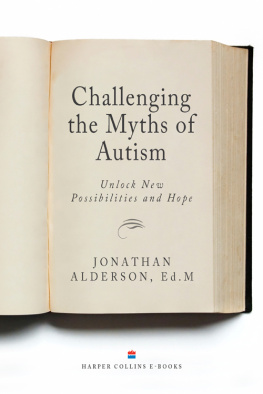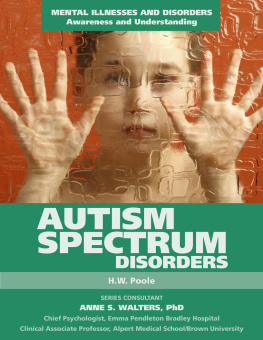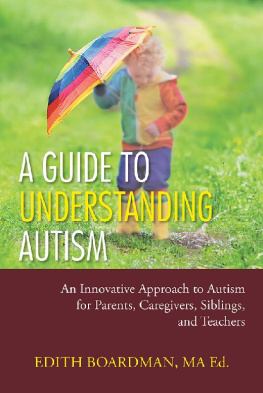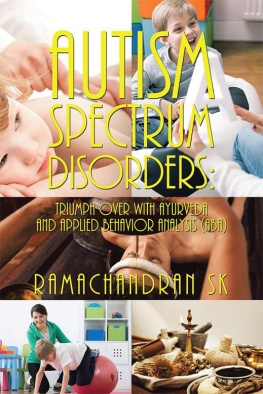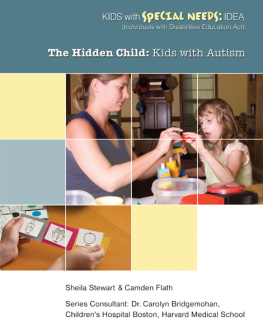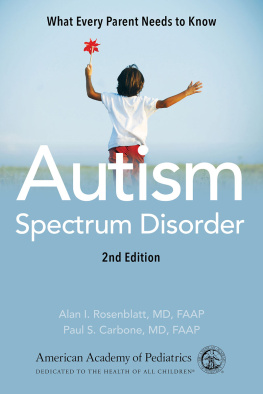JONATHAN ALDERSON, ED.M.
A psychiatrist has just one hour, squeezed in among a dozen other appointments, to observe a three-year-olds range of behaviours. The boy is already falling well behind his peers. He can speak but doesnt have conversations, and he doesnt play with toys normally. He lines up any objects he finds in rows and if someone moves them he tantrums as if his world has been destroyed. The psychiatrist is looking for a variety of clues that may add up to the necessary group of symptoms for a diagnosis. Its a complex process. After asking the parents a list of standard questions, the doctor is fairly certain their son has autism, but hes uncertain as to what degree.
At the end of the hour, the psychiatrist writes down autism spectrum disorder (ASD) on a form, followed by moderate in parentheses. The parents are devastated. He says he cant predict how far the boy will develop and hands them a list of phone numbers they can call to get their son on waiting lists for services as soon as possible. As they leave, a thousand unanswered questions flood their minds. Autism is an enigma affecting as many as 1 child in 100. It is estimated that there are almost 200,000 children with the disorder in Canada alone. We cant measure autism in blood or in urine; it is isnt associated with a persons temperature or blood pressure. Instead, autism is characterized by a group of behavioural symptoms that the doctor observes and then, using a rating scale like the ADOS, determines if the child looks autistic enough. Autism is typically first detected in early childhood but sometimes not until later. Children with autism have a range of complex neurodevelopmental impairments that affect communication and language, socialization and relationships, and they may display stereotyped behaviour of repetitious and ritualized routines.
Autism is a spectrum disorder, which means the symptoms range from mild to moderate to severe. Classic autism is considered fairly severe, while Aspergers syndrome is considered a milder form of autism. However, the criteria for diagnosing autism have changed over time and are still being debated to this day. In other words, there still isnt consensus about what autism even is. Its not uncommon for parents to get two or more different opinions about the severity of their childs autism, or even confirmation that its autism at all.
Yet more children will be diagnosed this year with autism than with AIDS, cancer, and diabetes combined. Rates of diagnosis have gone up dramatically over the past ten years especially. This fact alone leads to a widely debated issue: Some say the increase is due to the definition of autism being broadened to include more kids with milder forms of the disorder who, in the past, would have been labelled as delayed learners or socially awkward. Others believe rates have increased because of vaccines, or because the environment is getting more toxic. There is so little consensus, entire books have been written for and against each of these theories, packed with science and real-life anecdotes to support either compelling side of the argument.
Even though researchers have been looking at autism in children for about 70 years, since it was first identified in the early 1940s, we still dont know much about what causes it. The autism-vaccine link is hands-down the most debated and contentious issue. The arguments arent explained well in the media and so Vaccines Cause Autism headlines have triggered more fear than understanding. Some researchers, like Dr. Andrew Wakefield, have proposed that the measles virus in the measles, mumps, and rubella (MMR) vaccine finds its way into the intestines and causes an inflamed bowel condition similar to Crohns disease. According to the theory, the inflammation causes leaks of proteins back into the blood, affecting the brain and causing autism. But, as chronicled by Paul Offit in Autisms False Prophets, Wakefields research has been harshly criticized and discredited, most importantly, by his own medical community. Offit and others call Wakefields MMR theory a myth. However, in a situation as enigmatic as autism itself, there are two, three, and even more sides to most theories concerning the condition. In Evidence of Harm, New York Times reporter David Kirby presents compelling reports and data that vilify drug companies and support Dr. Wake-fields vaccine-autism link. (Recently, Wakefield authored his comprehensive self-defence, Callous Disregard.) Meanwhile, parents are left to sort through mountains of conflicting information while their childrens health is at stake. The number of children getting the MMR vaccine has decreased and, as a direct result, the number of children infected with the measles virus has gone up. Outbreaks of measles have resurfaced in underimmunized communities (putting children at risk for brain inflammation and even death), demonstrating the high stakes of sorting myth from truth.
Recently, there has been a flurry of genetic studies, and a few genes have been identified that might make a child more susceptible to developing symptoms. However, most researchers agree that autism is not dependent on genetics alone but is likely a matter of epigenetics, in which genes interact with triggers in the environment. There still is no evidence of a simple autism gene.
While experts cannot agree on what causes autism, theres also no consensus on exactly how to treat it. By far, the most widely promoted and researched approach is behaviour therapy. In Canada this is the treatment of choice of provincial governments and school boards. Research has shown behaviour therapy can help to educate and improve the functional behaviour of up to 50 percent of children with autism. But what about the other 50 percent? Since children diagnosed with autism have multiple learning and behaviour challenges, there is no one treatment or therapy that can deal with all of their needs. As a result, there has been a wide-open market for almost any type of service or product for treating autism. Treatments on offer range from swimming with dolphins to infrared saunas, cod liver oil, intensive desk-work drills, skin-brushing regimes, hyperbaric oxygen therapy (HBOT), dance classes, video games, and specially trained dogs. The number of options that parents have to choose from is overwhelming. Some of these treatments are based on scientific evidence. Others seem more fiction than fact.
I had just finished four years of child development and educational psychology studies at university with plans for a career improving the curriculum in public schools. No one in my family had autism. I didnt have any neighbours or friends that I knew of with autism, and the disorder wasnt covered in the media like it is today. I had no previous experience with autism beyond a few pages in a psychology textbook. In these pages, I had learned that children with autism also have mental retardation, except for a few savants who are superintelligent in one specific area. I learned that people with autism are aloof and sadly cant share affection with others. The textbook also explained that children with autism cant form attachments to their parents, and cant learn how to play like other kids do.
The summer after my graduation, I had an experience that would shape the direction of my career and my lifes interest since. I was invited to observe a play-therapy session at the Autism Treatment Center of America, nestled in the Berkshires of Massachusetts.

